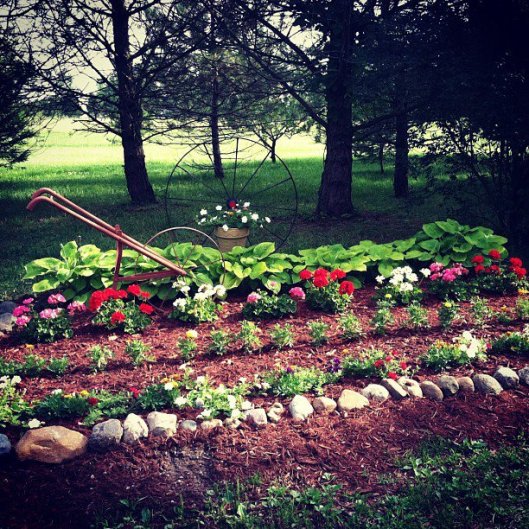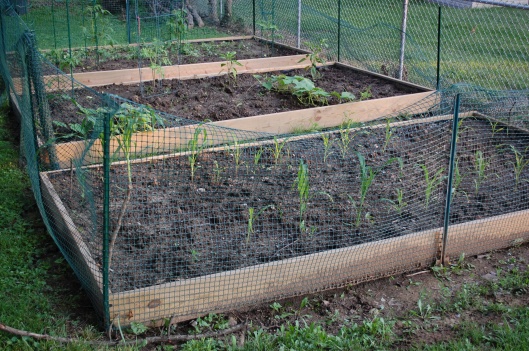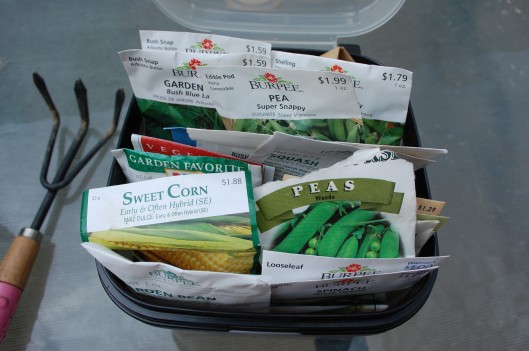Tags
Let me begin this experiment by confessing that I am, in fact, a terrible gardener.
I have seen people who are truly good at it-those with that enviable ability to lay out all their vegetables in perfectly neat, clean rows, in dazzlingly rich soil made more favorable by years of mulching, fertilizing, and careful tending-followed by rows and rows of tall, green, luscious plants straight out of Better Homes and Gardens.

This is just the flower bed. Her vegetable garden is a sight to behold. Photos will come later this summer.
My gardens tend to be small. They tend to be weedy. I tend to lose interest in August, when the weather gets unbearably hot and the air is thick and the thought of losing even one hour of precious lazy time before the rush of school and schedules takes over makes me take to the hammock swing or the pool chair with no intention of moving.
I spent a lot of time in my mother’s garden growing up-and hated every minute. I believe that I even once told her, “When I grow up, I’m buying my vegetables in the store-like a modern person!” Don’t you love it when you end up eating your own words?
As soon as my husband and I moved into our first place, a duplex in a beautiful neighborhood in South Toledo, I convinced my landlord to let me plant a tiny garden in the backyard. The only available ground space was along the fence line, a plot about 20 feet in length and two feet wide. I planted beans and cucumbers and corn and tomatoes-not very many, but I tended it and watered it and weeded it daily and it yielded a delicious harvest that I could be proud of! I’m a natural, I thought.
Once we moved to Cincinnati, I commanded my husband to rent a tiller and plow up a section of ground that looked like it had been used for a garden by the previous owner. But it was too close to the house, and too shaded, to be successful. Also, I learned that the rabbits, deer and raccoons here are RUTHLESS when it comes to eating your plants. I had a couple of really terrible years and I nearly gave up. I’m terrible at this, I thought.
Eventually, I moved my plot into a more sunny location and went to all raised beds to avoid the native clay soil (OMG clay soil is the worst. I could have made some great pots and pitchers from my garden soil, if only I’d had a pottery wheel.) Now my biggest garden foes and disease and my own laziness.
I often spend my garden time thinking about the farmers who make up my ancestors-the Germans who came to this country in the 1830’s and settled in Ohio. What did my great-grandmother plant in her garden? Were her crops different from mine? How did she fight off pests and disease before the age of Roundup and MiracleGro?

My maternal great-great-great grandmother, Catherine Gertrude Pfeiffer. Born in Germany in 1808, died in 1881. I have no idea when this photo was taken but it was sent to me by the Henry County Ohio Genealogical Society.
This year, I decided to try something new-the vintage garden. Well, sort of. Here’s the way it’s going to work.
I am not starting with Heirloom seeds, which would be more authentic. I have a whole box full of seeds from previous years and I’m going to use them. I have to believe my frugal ancestors would understand. Yes, I know there are gardeners who would advise against the use of old seeds. Honestly, I’ve done it before and they grow, in the right conditions, just as well as new ones. And anyway, who knows how long those seeds you just bought have been sitting in a store or warehouse…
I am going to use methods and suggestions for weeds and disease and fertilization that I’ve found in the various cookbooks I’ve collected. Yes, those old cookbooks contain more than recipes-there are chapters on laundry and housework and gardening! For instance, Housekeeping in Old Virginia, published in 1879, has a recipe for strawberry fertilizer that involves mixing a concoction of nitrate of potash (also known as potassium nitrate), glauber salts (sodium sulfite), sal soda (Arm and Hammer Washing soda), nitrate of ammonia, and water. I wonder if it works!

I wish I had a garden like this! These are the fields at the Firestone Farm at Greenfield Village in Dearborn, Michigan. Sigh….
So that’s the plan. At the end of the season, I’m also going to try my hand at seed saving, which was common in the days before commercial seed marketers.
Wish me luck!



I hope this season is a great one for your garden and for the goals you have set for yourself! I am trying Spring veggies this year, as last year I did not establish my garden till late May.
I am so excited it is finally warming up! It feels great to be outside again. I look forward to hearing more about pest and weed control solutions you discover, there are so many great home remedies for these issues. So much better than chemicals!
Thanks for sharing and happy gardening!
Thanks and good luck to you!!
Let me start by saying that every gardener has bad years. Last summer was beastly hot and dry. The one thing that saved much of my garden (but not all) were trickle hoses…the hoses with little holes in them. My husband and I used those daily for a long time, rotating them to different areas of the garden. I learned a lot about gardening from my dad. My job as a kid was to help harvest, clean the veggies or fruit, and to help can. I love digging in the dirt. Gardening gets you outside under God’s sky…
Nice article, Angela. Has a very homey , comforting feel to it.
Thanks mom!!
Good luck Angela, I have a brown thumb. I will be following your updates.
As a fellow gardener on the other side of Cross County Hwy, I feel your pain! With three raised beds, we managed to successfully harvest cucumbers, zucchini, LOTS of tomatoes, kohlrabi and lettuce. Even tried our hand with some blueberry bushes and after some delayed research learned they won’t even yield for another year or so. DOH!
Unfortunately, the rabbits dined quite fine on the green beans and the bugs devoured the hot peppers. But I was successful in canning several jars of salsa, buttered pickled chips and zucchini relish and we’re giving it another garden go with a different plan of attack, different repellents and a much taller fence.
We’ll compare notes and see what works. 🙂 Go for it girl! Fresh is indeed best.
Pingback: Vintage Garden: Planting the Early Crops | Bite From the Past